The post 10-Day New Mexico Road Trip Itinerary appeared first on The Blonde Abroad.
from The Blonde Abroad https://ift.tt/2D5Rz3E
The post 10-Day New Mexico Road Trip Itinerary appeared first on The Blonde Abroad.
The post 10 Healthy Habits to Adopt Moving Forward appeared first on The Blonde Abroad.
The post The Ultimate Southwest USA Road Trip Itinerary appeared first on The Blonde Abroad.
The post The Ultimate Two-Week California National Park Road Trip Itinerary appeared first on The Blonde Abroad.
The post A Two-Week Bolivia Itinerary For Adventurers appeared first on The Blonde Abroad.

Summer is here, and with the pandemic still raging, many of us are stuck at home day-dreaming about international travel. But where can Americans travel right now?
The pandemic has canceled countless travel plans this year, and its looking like travel won’t be the same again anytime soon for many people.
While I’m not about to go into the ethics of traveling as a tourist during a pandemic, I know many Americans are wondering where they can go right now, as the list of countries open to US citizens is rapidly shrinking.
Some of us have been going on domestic road trips, renting RVs, and even buying campervans to explore our own country, but others were hoping to go overseas.
As a long-time digital nomad, I also know many nomadic types without a real home are looking for somewhere to lay low until the pandemic is over.
Thousands of remote workers who practice nomadic lifestyles and previously called places like Thailand, Spain, or Bali their temporary home now need to relocate.
Some countries like Georgia and Bermuda have even created special visas to entice these types of remote workers, which I’ll explain below.
So where can Americans legally travel right now during the pandemic?

Much of Europe has started the process of re-opening up for international tourism again, but not to Americans, as the virus continues to spiral out of control in large parts of the United States.
The European Union has banned most US tourists from the region to help prevent the spread of the virus, as well as because the United States has banned European tourists. It’s called “reciprocity“, something countries often do to each other. If you treat my citizens well, I’ll treat yours well. Or not.
Unfortunately while Iceland was hoping to open up to American tourists on July 15th, they decided to stick with the European Union rules, which means no US passport holders. European Union citizens and Canadians can visit Iceland right now though.
Americans can travel to the United Kingdom if they provide their journey & contact details, as well as self-isolate for 14-days. Breaking the quarantine could result in fines up to $1,200 per day!
You can find more information about traveling to the UK here.
Canada has closed its borders to most international tourists, including Americans. This is to prevent the spread of Corona virus within the country.
Only foreign nationals who are immediate family members to a Canadian citizen or permanent resident are allowed to travel to Canada, provided they stay in the country for at least 15 days to observe quarantine.
You can find more information about travel restrictions in Canada here.
Both New Zealand and Australia have closed their borders to foreign travelers, except under very specific circumstances.
You can find more information about travel restrictions in New Zealand here.
You can find more information about travel restrictions in Australia here.
Keep in mind that each country in this list has specific restrictions, that are constantly changing in some situations. It is important to check back with local governments and tourism boards before leaving on a trip.
In many cases, countries are requiring Americans to show proof of a negative COVID test within 48-72 hours of your departure to avoid a 14-day quarantine.
But due to the horrible testing situation in the United States, getting a COVID test result just a few days before your departure (when results can sometimes take over 7-days) may be very difficult depending on your state…
The CDC also advises against all nonessential international travel.
I’ll try to update this list as I learn of any new information.
Aruba is currently allowing American tourists to visit, as well as tourists from other countries. Visitors will be screened with temperature checks and COVID-19 testing on arrival. However if you’re flying from one of 20 American states considered high-risk, you will need to upload proof of a negative COVID test within 72 hours of flying.
If you’re tested on arrival, you’ll have to quarantine in a hotel for 24 hours while waiting for the test results. You’ll also have to pay for the test.
You can find more information about traveling to Aruba here.
The Bahamas WAS allowing American tourists to visit, however on Wednesday July 22nd they are shutting down the country to US Citizens. Visitors from Canada, the United Kingdom and European Union will still be allowed to travel to the islands with proof of a negative COVID test at least 10 days before arrival.
You can find more information about traveling to the Bahamas here.
Barbados is currently allowing American tourists to visit, as well as tourists from other countries. Visitors will be subject to temperature checks, social distancing, and wearing face masks.
If traveling from a high-risk country, like the United States, you’ll be required to show proof of a negative COVID-19 PCR test within 72 hours of flying. You’ll also be required to take another test on arrival and quarantine at your hotel until the results are returned.
You can find more information about traveling to Barbados here.
Barbados has gone one step further, however, and is inviting digital nomads and remote workers to come wait out the pandemic while working from their white-sand beaches.
The Barbados Welcome Stamp will soon allow visitors to stay on the Caribbean island visa-free for up to one year. The aim is to attract remote workers to live and work on the island while contributing to its economy. Sounds like a great deal!
Belize is currently allowing American tourists to visit, as well as tourists from other countries. Visitors will be subject to temperature checks, social distancing, and wearing face masks.
Americans will be required to show proof of a negative COVID-19 PCR test within 72 hours of flying, or be tested on arrival and quarantine at your hotel until the results are returned.
Visitors will also be required to download and check in daily on the Belize Health App (NAC Belize).
You can find more information about traveling to Belize here.
Bermuda is currently allowing American tourists to visit, as well as tourists from other countries. Visitors will be subject to temperature checks, social distancing, and wearing face masks.
Americans, Canadians, British and other tourists from high-risk countries will be required to show proof of a negative COVID-19 test within 7-days of flying in order to receive a Travel Authorization.
You can find more information about traveling to Bermuda here.
Cambodia is currently allowing American tourists to visit, as well as tourists from other countries, provided they pay a $3000 deposit to cover the cost of COVID testing on arrival and possible quarantine if needed.
You can find more information about traveling to Cambodia here.
Croatia is allowing tourists from all countries to enter, including the United States. Croatia has decided to ignore the European Union restrictions, which is ultimately decided by each individual country.
Incoming travelers from the United States must show a negative COVID PCR test taken less than 48-hours before departure, or else submit to a 14-day self-quarantine on arrival.
You can find more information about traveling to Croatia here.
The Dominican Republic is currently allowing American tourists to visit, as well as tourists from other countries. Visitors will be subject to temperature checks, and will have to fill out a Health Affidavit to confirm they haven’t had any COVID symptoms.
Travelers with symptoms will have to be tested and isolated on arrival.
You can find more information about traveling to Dominican Republic here.
Egypt is currently allowing American tourists to visit, as well as tourists from other countries. Visitors will be subject to temperature checks, social distancing, and wearing face masks.
Incoming travelers from the United States and other COVID hot spots must show a negative COVID PCR test taken less than 48-hours before departure, or else submit to a 14-day self-quarantine on arrival.
You can find more information about traveling to Egypt here.
Georgia is currently NOT allowing most international tourists to visit, unless they happen to be remote workers looking to stay in the country long-term (at least 6-months). These people will have to apply online for advance permission to enter.
Visitors will be subject to temperature checks, social distancing, and wearing face masks, as well as a 14-day self-quarantine on arrival.
You can find more information about traveling to Georgia here.
The Maldives is currently allowing American tourists to visit, as well as tourists from other countries. Visitors will be subject to temperature checks, social distancing, and wearing face masks.
Travelers will not be required to take a COVID test on arrival unless they show symptoms. If they need a PCR test, they’ll have to wait in quarantine until the results come in.
You can find more information about traveling to the Maldives here.
The US-Mexico land border is closed to all but “essential crossings.” Non-essential crossings are prohibited until at least July 21, 2020. Some towns in Mexico near the border have also set up roadblocks to keep Americans out.
What about flying? Some Mexican states are open for tourism if arriving by airplane, like Quintana Roo, Oaxaca, Yucatan, Campeche, Mexico City, Jalisco, and Baja California Sur. They are desginated “orange” under the Mexican system, which means there are some restrictions, but it’s not a total lock-down.
You can find more information about traveling to Mexico here.
Yes, Puerto Rico is a territory of the United States, but because the American President thinks it’s a country (seriously, WTF), I thought I’d include it here.
Puerto Rico is currently allowing international travelers to visit. Visitors will be subject to temperature checks, social distancing, and wearing face masks.
Incoming travelers must show a negative COVID PCR test taken less than 72-hours before arrival, or else submit to a 14-day self-quarantine on arrival while you wait for test results.
You can find more information about traveling to Puerto Rico here.
Serbia is currently allowing Americans and other international travelers to visit. Visitors will be subject to temperature checks, social distancing, and wearing face masks.
There is no mandatory quarantine at this time. Serbia is located in southeast Europe, but is not part of the European Union.
However travelers should be aware that the country is currently in the middle of mass protests against the government.
https://ift.tt/3jpcrTS
St. Barts is currently allowing Americans and other international travelers to visit. Visitors will be subject to temperature checks, social distancing, and wearing face masks.
Incoming travelers must show a negative COVID PCR test taken less than 72-hours before arrival, or else submit to a 14-day self-quarantine on arrival while you wait for test results.
Those staying longer than a week will need to pay $150 for another COVID test on the 8th day. The only way to fly to the island is via Antigua or San Juan Puerto Rico — their main international airport (Princess Juliana) is closed to flights from the United States.
St. Lucia is currently allowing Americans and other international travelers to visit. Visitors will be subject to temperature checks, social distancing, and wearing face masks.
Incoming travelers from the United States must show a negative COVID PCR test taken within 7 days of travel, and complete a Pre-Arrival Registration Form before traveling.
You must also have confirmed reservations from a COVID certified accommodation provider.
You can find more information about traveling to St. Lucia here.
Tanzania is currently allowing Americans and other international travelers to visit. Visitors will be subject to temperature checks, social distancing, and wearing face masks.
Travelers will be required to fill out a Health Surveillance Form on arrival.
However while this is the official Tanzanian government stance, locals are urging tourists to stay away, as they believe the virus is not under control in their country.
Tanzania is not releasing its COVID data to the public, so there is no clear picture of what the situation is like on the ground.
You can find more information about traveling to Tanzania here.
Turkey is open to Americans at the moment. Passengers arriving in Turkey will be required to complete an information form and will be checked for symptoms.
Anyone suspected of having COVID-19 will be transported to a hospital for examination. You could be subject to 14-day isolation/quarantine if someone else in the plane tests positive.
You can find more information about traveling to Turkey here.
The US Virgin Islands, also a territory of the United States which includes the islands of St. Thomas and St. Croix, is currently allowing other Americans to visit. Visitors will be subject to temperature checks, social distancing, and wearing face masks.
Incoming travelers with symptoms will need to be tested and quarantined on arrival.
Healthy visitors will be free to leave their hotel and explore the rest of the islands.
You can find more information about traveling to the US Virgin Islands here.
It is important to note that the COVID-19 pandemic is still spreading around the world. Most experts warn against traveling internationally for tourism.
Whether traveling during a pandemic is responsible is up for individuals to decide. Everyone will have to make their own choices and live with the consequences.
I simply wanted to put together a list of options for people traveling on US passports, because this information is scattered around online and pretty confusing at the moment as regulations continue to change on week-to-week basis.
If you think I’m missing any countries in this list, feel free to comment below so I can look into the latest restrictions and re-openings.
This is a post from The Expert Vagabond adventure blog.
The post The Ultimate Weekend in Alaska Road Trip Itinerary appeared first on The Blonde Abroad.
The post How to Travel Safely During COVID-19 appeared first on The Blonde Abroad.
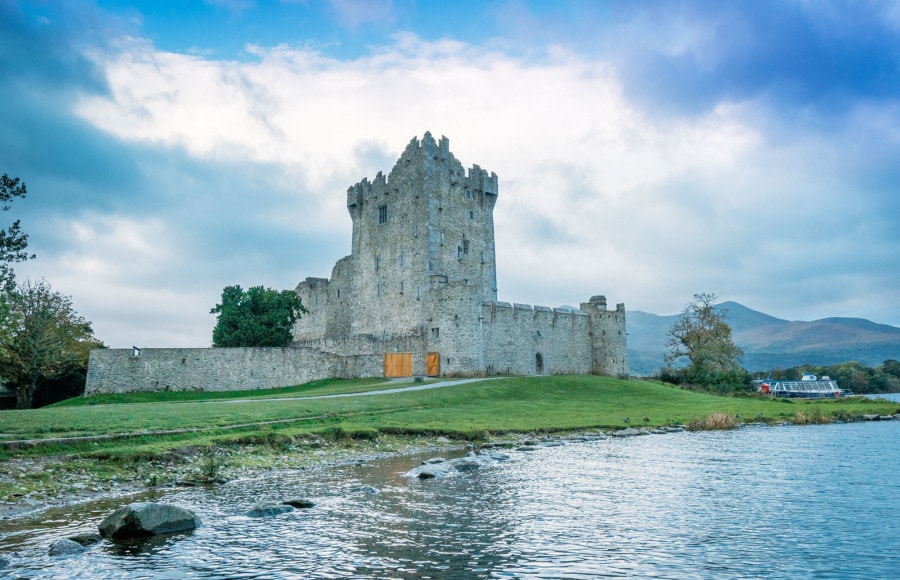
Killarney is a small town in Ireland with rolling hillsides, ancient castles, pristine lakes, and its own National Park. Here are some of the best things to do in Killarney!
After traveling to Ireland a few times now, I can safety say that Killarney National Park (Páirc Náisiúnta Chill Airne in Irish) and its surroundings were one of my favorite parts of the country.
Right up there with Dublin and the Cliffs of Moher!
If you close your eyes and imagine Ireland, you probably think of rolling green fields and charming villages. Killarney certainly meets those expectations.
Killarney has some of the best natural wonders in Ireland. The town sits on the shores of Lough Leane in Ireland’s southwest County Kerry, and is part of the famous “Ring Of Kerry” drive that lures many foreign tourists.
Whether you’re in the mood for some Irish culture and history in Killarney Town, or prefer an outdoor adventure in Killarney National Park, the area has it all.
After having an amazing time there, I wanted to share some of my favorite things to do in Killarney, Ireland if you happen to be planning a trip.
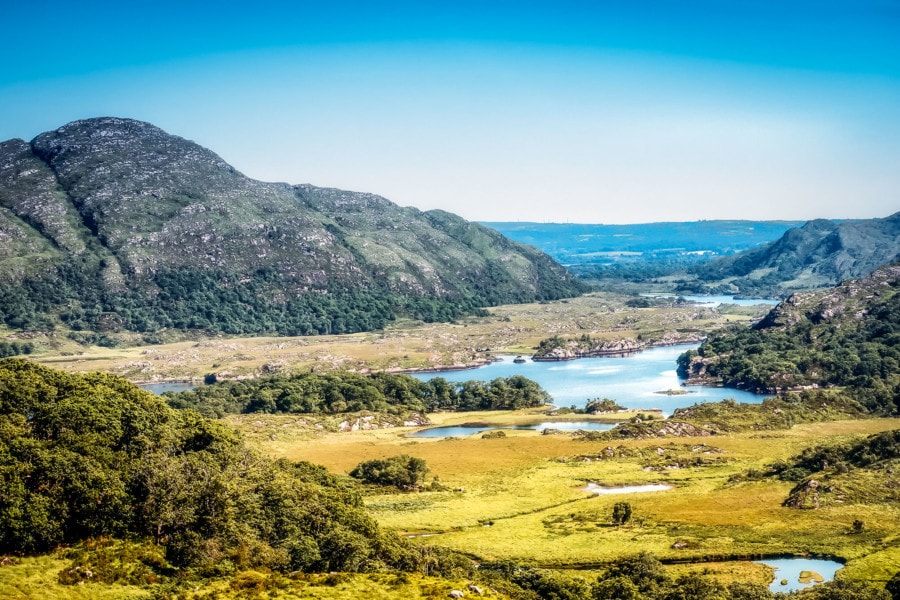
Killarney National Park is made up of mossy valleys and woodlands — famed for its beautiful mountain ranges, castles, lakes, and waterfalls.
Killarney became Ireland’s first national park in 1932 when Muckross Estate was donated to the Irish Free State. Today, it covers 25,000 acres.
Outdoor lovers can explore the forests to appreciate the incredible ecological diversity, including the Lakes of Killarney, plus oak and yew woodlands.
It’s free to enter the national park, but some of the attractions inside may have entry fees.
Many of the highlights I mention below are part of the National Park, with the others are right next door. There’s a lot of fun things to do in the area!
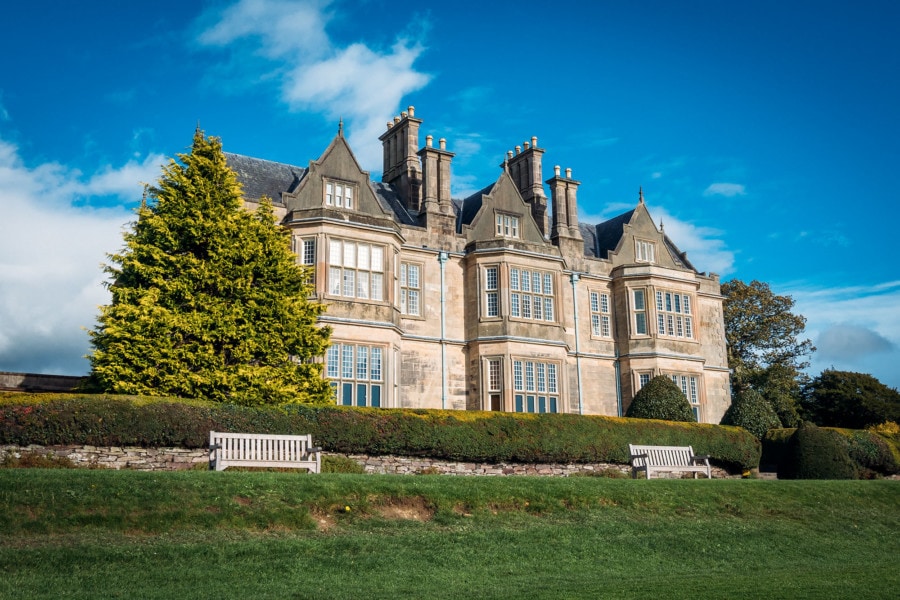
The Muckross House Gardens stand near Muckross Lake in Killarney National Park. This stunning Victorian mansion was built for Henry Arthur Herbert and his wife, water colorist Mary Balfour Herbert, in 1843.
Lord Ardilaun of the Guinness family purchased the home in 1899. Guests can tour the home, gardens, and working farms all year long. Rooms contain elegant period furniture to reflect the lifestyle of its previous inhabitants.
Thick ivy climbs its stone walls, changing color with the seasons, and extensive manicured gardens compliment the mansion.
The grounds contain three separate working farms, as well as the ruins of Muckross Abbey (with a tree growing inside!) The farmhouses contain traditional style dressers, beds, and meal bins. You can also visit the Labourer’s Cottage, a Carpenter’s Workshop, and a Blacksmith’s Forge.
9am – 6pm
House tours cost €9 EURO. Wandering the grounds is free.

Located on the edge of Lower Lake in Killarney National Park, Ross Castle is a renovated castle just a few minutes’ drive from town. The ruling clan O’Donoghues Mór built the castle in 1537. It has since been the setting of many battles over the centuries.
Visitors can go on guided tours of the castle during summer months. The castle also hosts boat trips from Ross and Reen piers to Innisfallen Island on the Lower Lake and to Lord Brandon’s Cottage on the Upper Lake.
Locals say that the castle’s original owner, O’Donoghue, killed himself by leaping out of a window into the lake. He supposedly continues to haunt the lake, circling it on a white horse every seven years on the first of May.
Anyone who catches a glimpse of the ghost will enjoy a lifetime of good fortune!
March 7th – October 22nd: 9:30am – 5:45pm
No fee to enter, but guided tours are €5 EURO.
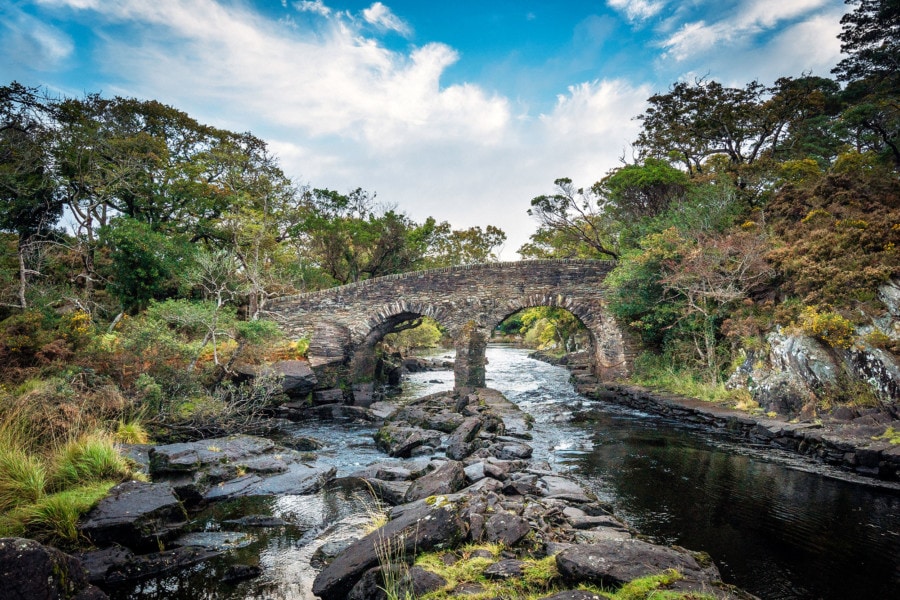
Like much of Ireland, in Killarney, you can find ample examples of centuries-old ruins scattered throughout the countryside. Old Weir Bridge is an ancient stone arch bridge where the three main lakes of Killarney meet.
Historians believe the bridge dates back to the 16th century. To get here, you can take a boat tour, bike, or walk. There is no road access, but there is a car park on the N71. From there you can walk to Dinis Cottage (and have a coffee), then follow the footpath to Old Weir Bridge.
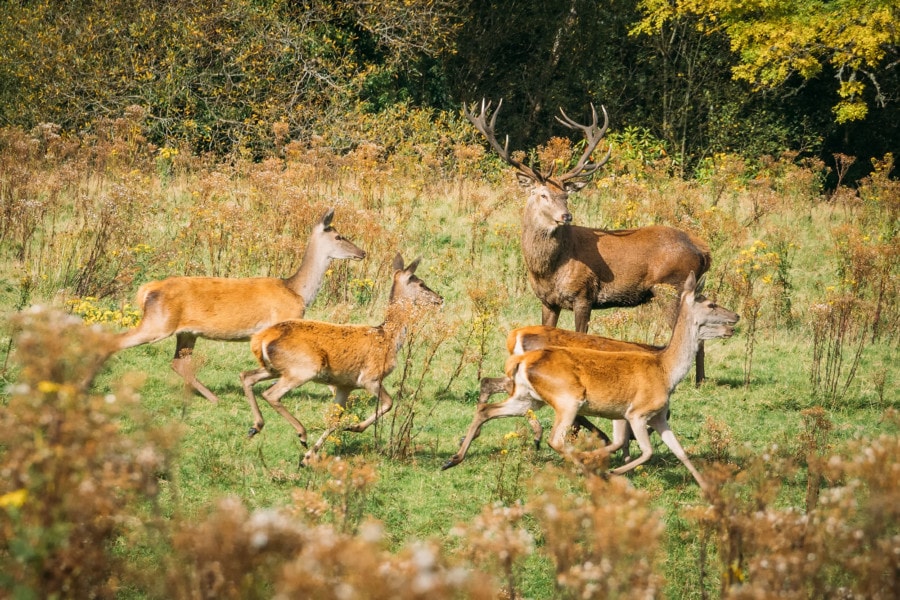
While exploring the Killarney National Park, you’ll likely spot Ireland’s largest mammal (and the second largest in Europe), the red deer. Red deer have a reddish-brown coat. Male stags grow up to 240 kg (530 lbs) and boast impressive antlers.
You can see them all year long, but late spring is calving season and the best time to see young fawns.
I was lucky and happened to be there in October during the annual “deer rut”, when rival stags fight each other for the attention of females.
The best places to see red deer are Knochreer Estate opposite Saint Mary’s Cathedral as well as the Muckross House area. Keep your ears open for their distinctive ghost-like sounds or the growls of males throughout the park.
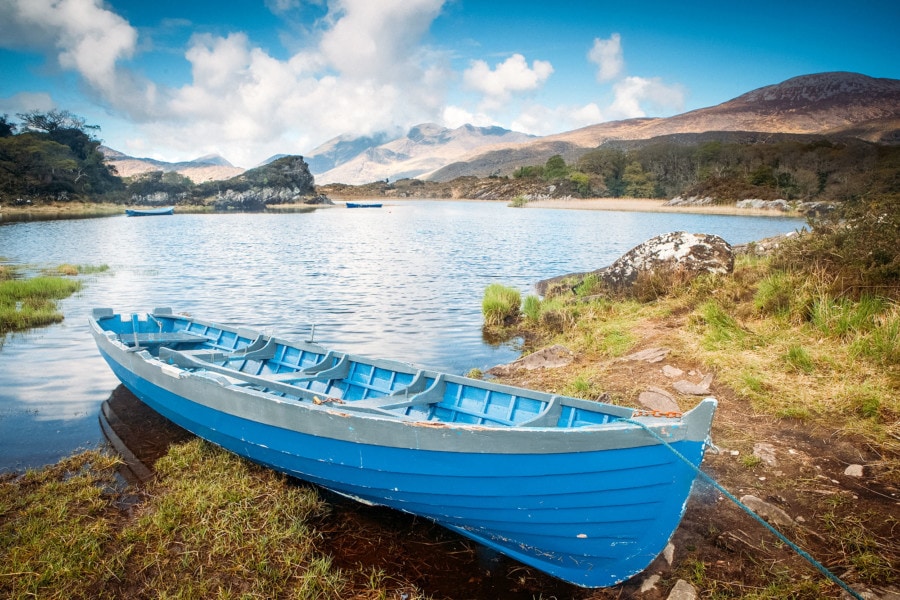
The lakes of Killarney are an ideal destination for enjoying the outdoors and seeing wildlife. Lush woodlands and towering mountains surround the region’s three lakes: Lough Leane, Muckross Lake, and Upper Lake.
You can also book a boat tour or kayak tour of the lakes, if you’d like to get out on the water for a bit.
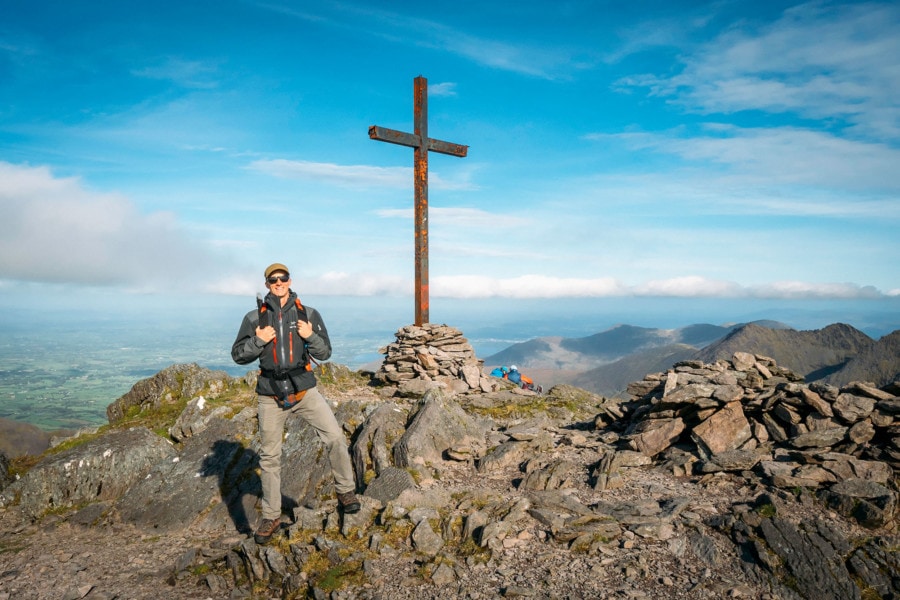
One of my favorite experiences in Ireland was hiking Carrauntoohil Mountain in the Macgillycuddy’s Reeks mountain range. The tallest mountain in Ireland!
There are many fun hikes in this area, including a few different options to reach the top of Carrautoohil.
I chose the more difficult Coomloughra Horseshoe, a 6-8 hour trek over all three of Ireland’s highest peaks: Beenkeragh, Carrauntoohil, and Caher.
Whichever trail you decide to tackle, caution is needed as the hiking can get dangerous in bad weather. These mountains may not be huge, but they can still pack a punch!
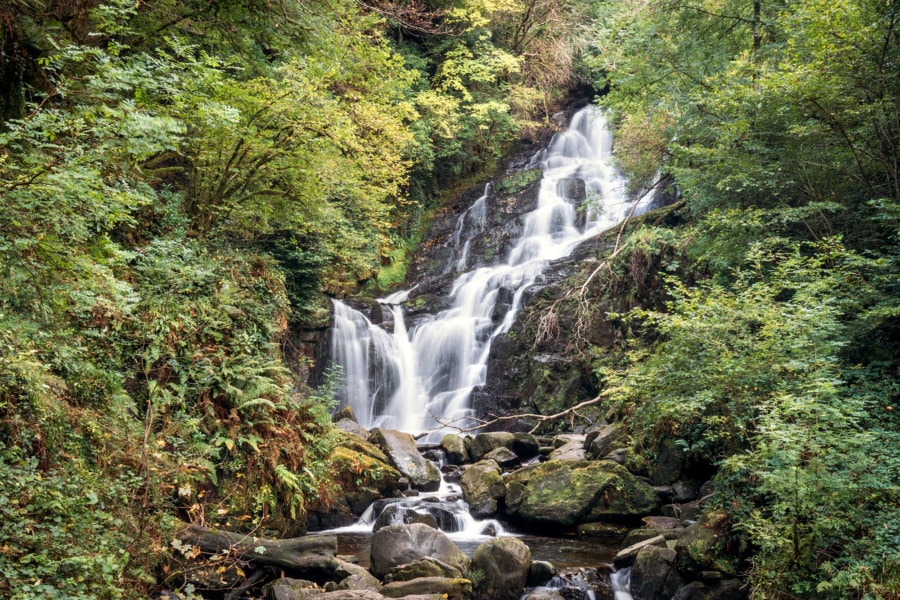
Torc Waterfall is a popular attraction in the area, and just a 5-minute walk from the road, so it’s a great activity for kids. The Owengarriff River drops 80 feet into this pretty waterfall surrounded by woodlands.
For the more adventurous, there are many other trails around the waterfall, including the Torc Mountain Trail, a rocky 2-hour hike that gives you excellent views of Killarney National Park.
There’s also the Huntsman’s Hill trail which loops 3.5 km (2.1 miles), and the Torc Loop, a more moderate hike that takes about 40 minutes.
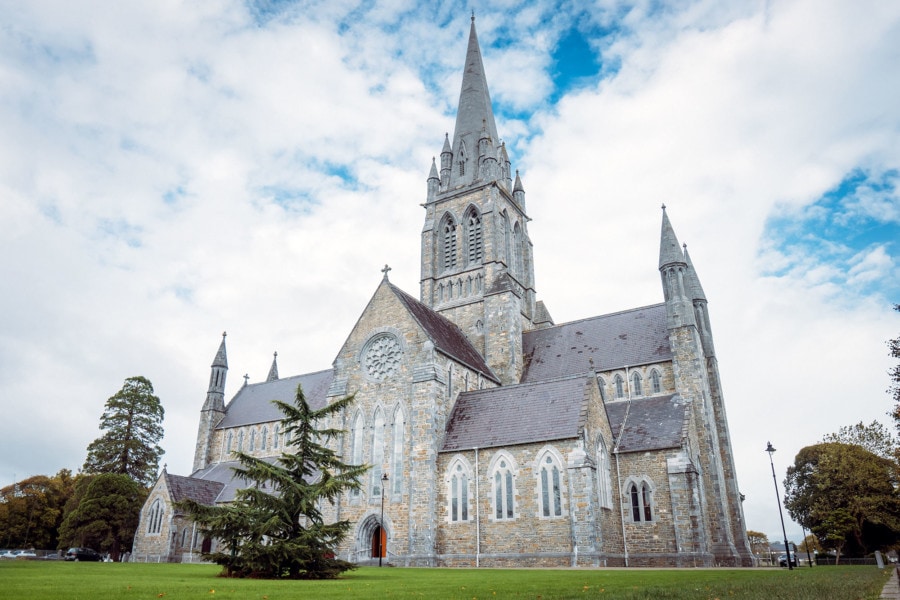
Located just a five minutes’ walk from the shopping precinct in Killarney, St. Mary’s Cathedral has some impressive stonework and stained glass windows making it well worth a visit.
Soaring ceilings provide ideal acoustics when the organ plays during mass. The cathedral frequently hosts weddings and other church services.
Designed by Augustus Welby Pugin, construction began in 1842 but came to a pause during the great potato famine. It was finally finished in 1907.
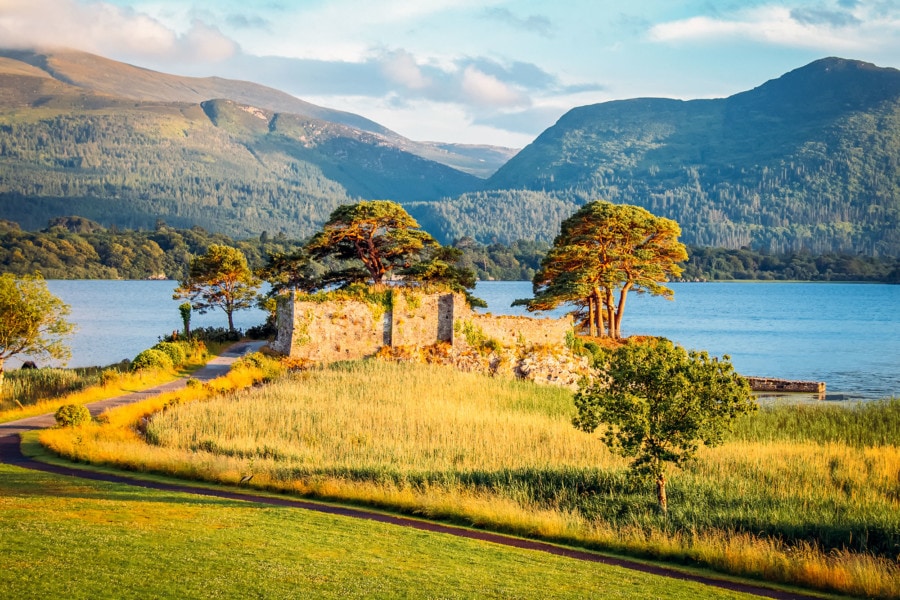
The historic Castlelough Castle overlooks Lough Leane, Killarney’s Lower Lake. Historians believe the Anglo-Norman De Roches built the castle in the 12th or 13th century.
In 1262, the Gaelic MacCarthys took over the castle after a battle between the Anglo-Norman and Gaelic forces. It remained under MacCarthy control until the reign of King George II in the mid 18th century.
The Lake Hotel and Castlelough Restaurant now sits next to the ruins. The surrounding mountains and woodlands make this an ideal place to stay while visiting the Irish countryside.
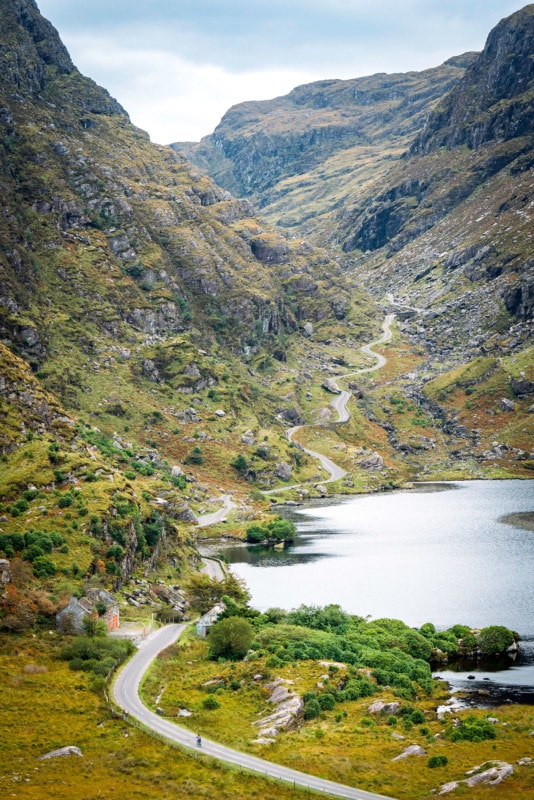
Formed over 25,000 years ago, the Gap of Dunloe was created by a glacier breach in the Black Valley. This narrow mountain pass splits the MacGillycuddy’s Reeks mountain range in the west from the Purple Mountain range in the east.
Its name Dunloe comes from Irish, Dún Lóich, meaning “Lóich’s stronghold”. Legend says Mac Lóich was the father of the five chieftains who conquered and ruled over Ireland for 37 years from 3266 BC.
The road is single lane, with turnoffs in case you encounter oncoming traffic. But I recommend walking the road, biking it, or hire a jaunting horse cart starting from Kate Kearney’s Cottage. The 5-mile round-trip journey passes small farms, lakes, and rugged mountains.
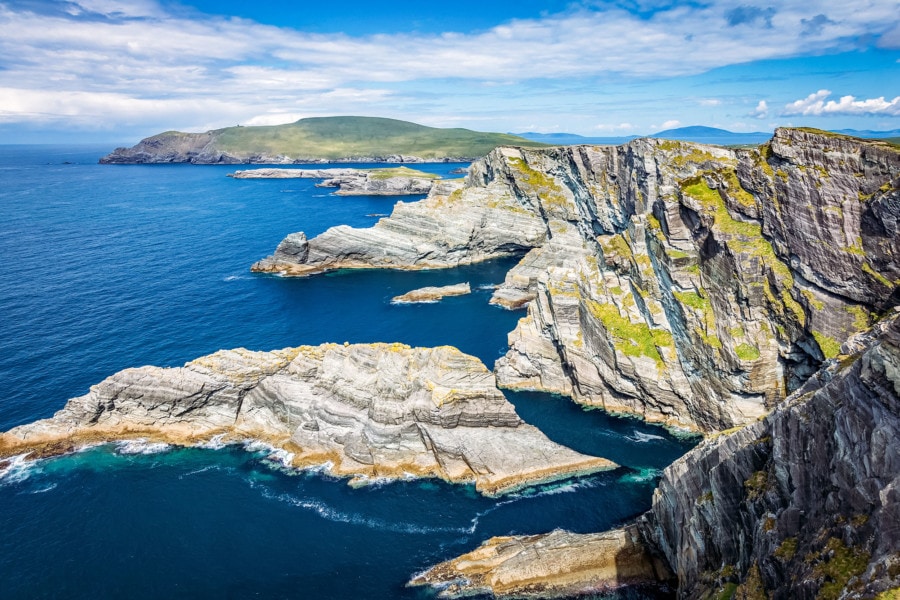
Killarney is the starting point for the Ring Of Kerry, a popular circular road trip in Ireland. Ancient stone ruins dot mossy green hillsides and craggy shorelines along this coastal road.
Meant to be driven counter-clockwise (due to some single-lane roads), the route passes many scenic and historical Irish landmarks.
Unfortunately I didn’t have time to drive the Ring Of Kerry, as there was plenty for me to do just around Killarney for 3 days before moving North to explore the Dingle Peninsula.
I recommend heading to Murphy’s of Killarney for a pint and a chance to mingle with the locals.
Murphy’s features live music plays in a cozy atmosphere, with traditional pub fare including shepherds pie, Guinness beef stew, and fish and chips.
Bricin means “small trout” in Gaelic, and is also the name of a stone bridge in Killarney National Park. Bricin is also a popular restaurant in a restored historic building on High Street.
The antique timber and stained glass windows call guests to dine in an inviting atmosphere. Local folk crafts and artwork decorate the walls.
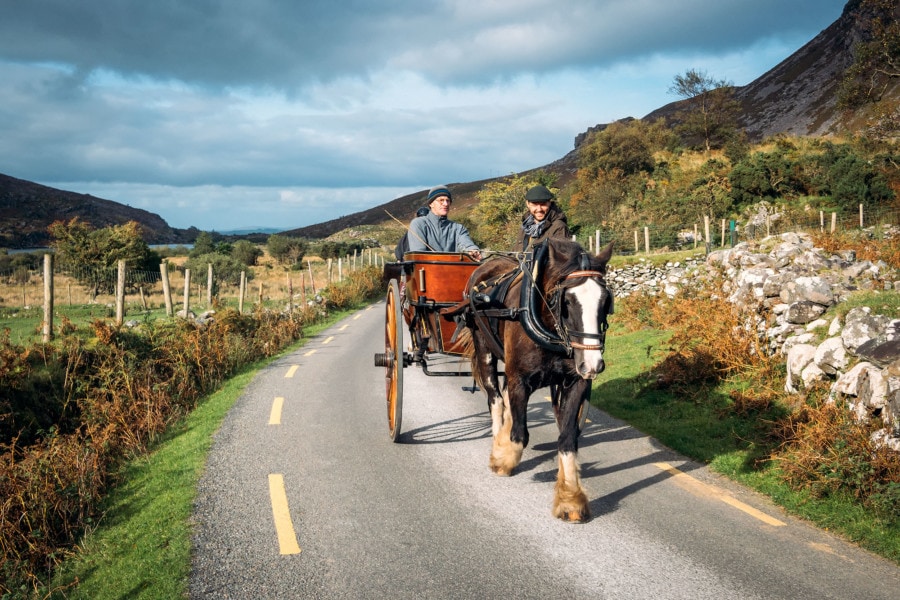
The best site to book your car is with Discover Cars. They search both local and international car rental companies to help you find the best possible price. This is the easiest way to rent a car in Ireland.
Renting a car offers the best flexibility to explore remote parts of Ireland, and avoid the big tour groups.
If you don’t have a car, the best option is to do the hop-on-hop-off bus from Killarney Shuttle Bus. It takes you from Killarney to all the main attractions in Killarney National Park.
There is local taxi service around Killarney, but I’d use them as a last resort.
During your time in Killarney, you’re sure to see plenty of horse-drawn carriages called “Jaunting Carts” or “pony-and-trap” throughout the National Park. This is a popular way for tourists to get around. You can go for short rides, or a full-blown National Park tour with different stops.
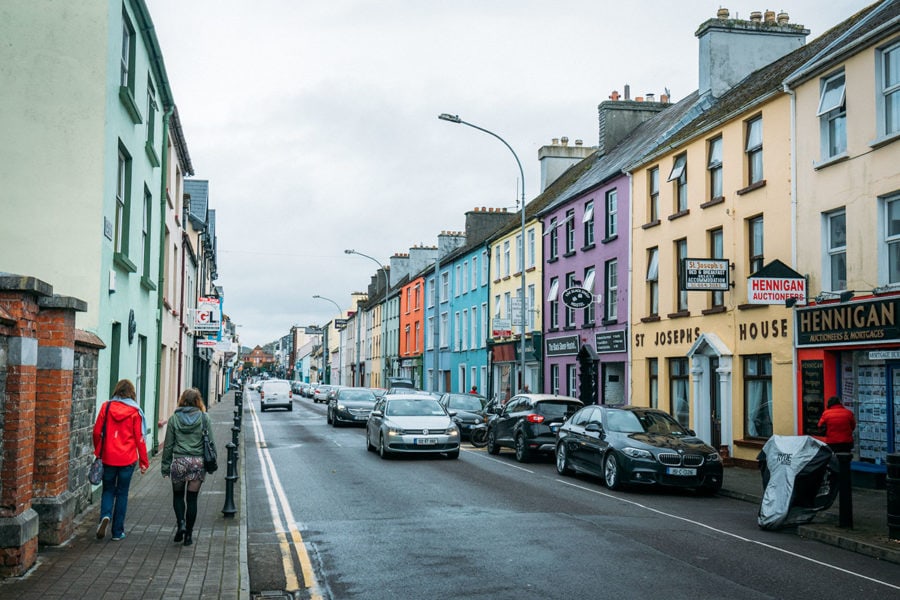
Check out my travel gear guide to help you start packing for your trip.
Ready to fly? Here’s how I find the cheapest airline flights.
Discover Cars is a great site for comparing car prices to find a deal.
Learn how I save money booking hotels & vacation apartments.
Don’t forget travel insurance! Protect yourself from possible injury & theft abroad. Read why you should always carry travel insurance.
Recommended Guidebook: Lonely Planet Dublin
Suggested Reading: 1916: The Irish Rebellion
I hope you enjoyed my guide on what to do in Killarney! Hopefully you found it useful. Here are a few more wanderlust-inducing articles that I recommend you read next:
Any questions about things to do in Killarney? Do you have other suggestions? Drop me a message in the comments below!
This is a post from The Expert Vagabond adventure blog.
The post How to Throw a French-Inspired Dinner Party appeared first on The Blonde Abroad.
The post The Ultimate Oregon Adventure Road Trip Itinerary appeared first on The Blonde Abroad.

A few years after I traveled to Cuba as an American, I received an official subpoena by the US Treasury Department for possible economic sanctions violations.
Four years ago I traveled to Cuba during the Obama administration, when travel restrictions to the island were progressively being relaxed and diplomatic relations were improving.
I decided to write about my Cuba experience online, predicting there would be a flood of American tourists as US flights, cruises, and tours began operating again after many years of arguably “unconstitutional” travel bans to the island for US citizens.
Just as I guessed, tourism soon exploded in Cuba, as Americans rushed to visit for the first time. Many people used my articles to help plan their trips.
But if you managed to travel to Cuba as an American during this relatively short window of freedom, you got lucky.
Because not long after President “grab em’ by the p**sy” took office, he began rolling back all the old US travel restrictions for visiting the island.

I’d heard rumors of some American tourists getting in trouble for visiting Cuba, and I was aware there was a slight risk, but I went anyway. I believed I fell under one of the authorized travel categories.
And for every odd story of a fine or warning, every year thousands of people traveled there with no consequences. It seemed to be a law with no real enforcement.
Well, my trip to Cuba finally caught up with me, and 3-years after my visit, I was subpoenaed by the US Treasury Department for any & all documentation about my trip.
Last year the government sent me an official subpoena by mail, to an outdated address that I haven’t used in years. I guess they couldn’t check with the IRS where I last filed my taxes from? The incompetence is really kind of sad.
Eventually, they sent me an email when I didn’t respond to the physical subpoena sent to that incorrect mailing address.

So, what’s it like to be subpoenaed by the US government? Well, honestly it’s a bit scary. My first reaction was “oh shit”. Don’t they have better things to do than harass and intimidate individual American tourists?
I mean, I’m a budget traveler who spent a total of about $900 in Cuba over 10 days. Staying with locals and eating at restaurants run out of people’s homes. It’s not like I’m funneling millions of dollars to the Cuban government…
My next thought was, maybe I should just ignore the subpoena like everyone who works in the Trump administration has been doing lately.
But then I remembered I’m not above the law like they seem to be… I’m just a regular dude with no real power, wealth, or connections. Getting picked on by a government run by bullies. Ignoring a subpoena will have consequences for me…

The Office of Foreign Assets Control is a financial intelligence and enforcement agency of the U.S. Treasury Department. It administers and enforces economic and trade sanctions in support of U.S. national security and foreign policy objectives.
By spending my money in Cuba as an American, for example buying food, going on a tour, or paying for accommodation, I was possibly violating the economic sanctions placed against Cuba.
But worse than that, I was telling other Americans about traveling to Cuba through my writing. I believe this is why I, as well as our friends who traveled with us, were targeted.
Because we wrote about our trip publicly and many people were reading it.
Did some of my money end up in the pockets of the Cuban government? Sure. We did our best to avoid it, but it’s literately impossible to not have some of your money end up in their hands.
Just as it would be impossible for anyone traveling to the United States to avoid giving money to the US Government in the process.
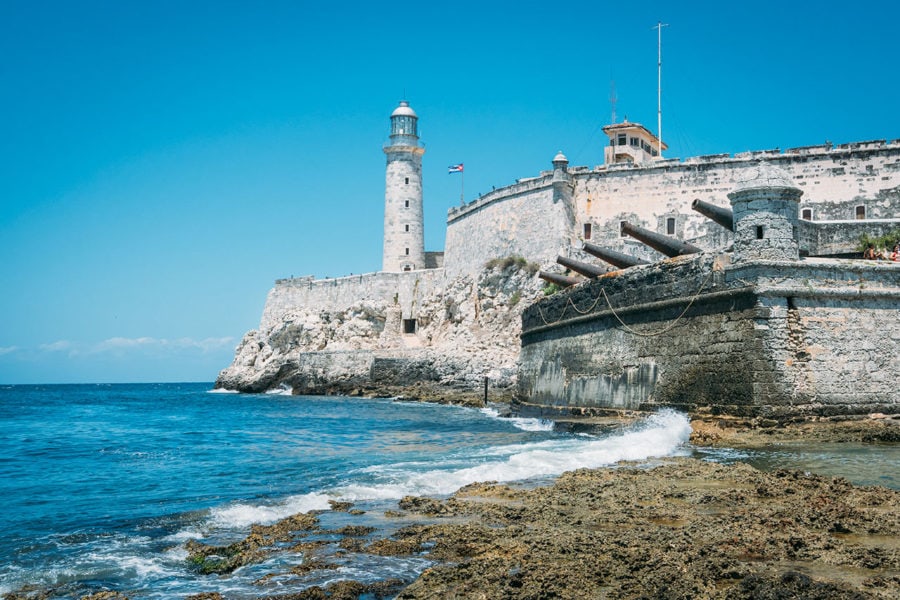
So I responded to the subpoena with a letter explaining that my trip was for journalist purposes, along with sending over copies of any remaining documents I had (flight receipts, accommodation information, itinerary, etc.). Remember, this trip was 3-years ago! I didn’t save much.
If you’re not aware, Americans are allowed to travel to Cuba if they fit one of the 12 authorized categories for visiting. They aren’t defined very well, and the rules are super confusing.
Because I run a website about travel for a living, I thought I’d fit under journalistic activity. Americans were traveling to Cuba on a regular basis under Obama, and I was covering that news.
It’s ok for CNN to write about traveling to Cuba, but not me? Over a million people have read my Cuba articles, it’s not like this is a hobby.
The government didn’t agree I was a journalist, but rather than fine me, they just left me with a warning. My guess is they wanted that warning to get shared, to discourage others.
“OFAC has decided to address this matter by issuing you this Cautionary Letter instead of pursuing other enforcement responses at this time. Upon issuing this Cautionary Letter OFAC will close this matter without making a final agency determination as to whether a violation has occurred and will not take any further action on the underlying conduct unless it learns of additional related violations or other relevant facts.”
Although personally I don’t think most people have anything to worry about. Just don’t write about your trip to Cuba and end up on the first page of Google!
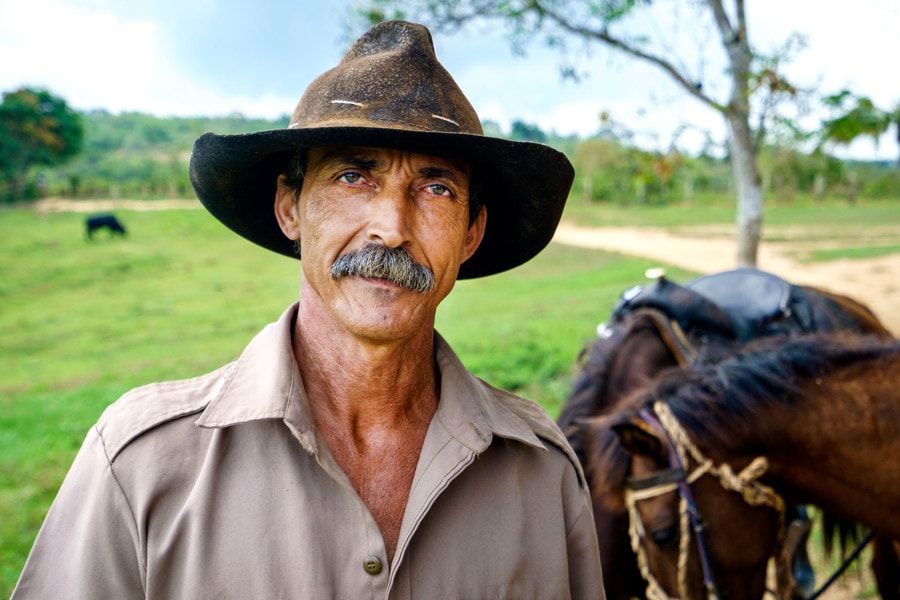
I’ve since learned that it would have been better to prepare a trip under the “Support For The Cuban People” category. There are a handful of companies that can help arrange trips this way like:
The trips involve strict itineraries, with many stops at organizations in Cuba that are supporting human rights in the country. Which is great.
But the problem with traveling on an organized tour like this is it’s not super fun for independent travelers like myself. I don’t want a babysitter when I travel.
I enjoy the challenges of discovering a new country on my own, without being led around by the hand. No offense to those who enjoy group tours, I’m just not one of them.
For all this talk about Americans having so much freedom, as someone who’s traveled (and lived) all over the world, exposed to many different cultures and systems of government, we definitely have some work to do in that department.
Fun fact, I’m also a citizen of Ireland. And guess what? Ireland doesn’t outright ban its citizens from traveling to other countries…
If the current US government wants to punish Cuba with economic sanctions, fine. But by using a constitutionally questionable loophole that prevents American citizens from freedom of movement, they are actually punishing Americans as well as the Cuban people they pretend to want to help.
I personally have no ill-will to the Cuban people, and think freedom of movement is a constitutional right — should I want to spend my money on tourism in Cuba. If Cuba doesn’t want us there, that’s their right. But they do.
At least they did before we totally screwed up our pandemic response.
Instead my own government is trying to prevent me from traveling to a foreign country, for dubious reasons. The Cuba travel ban isn’t for public health, or for cold-war era national security concerns.
Don’t get me wrong, the Cuban government is really shitty to its people. But so are many other countries without travel bans on them.
As an American, if you would like to regain the freedom of unrestricted travel, as other countries enjoy, remember that we CAN change US foreign policy by electing representatives who will make those changes on our behalf.
Joe Biden has made it clear he will return to the more relaxed Obama-era relations with Cuba if he’s elected President in November.
Here’s to hoping things change next year, and Cuba opens back up for tourism once again, with common-sense rules that are easy to follow.
Because Cuba is a beautiful and fascinating country to explore as a tourist! And the people there really do need the financial support of that tourism, too. ★
I hope you learned more about Cuba! Hopefully you found it useful. Here are a few more wanderlust-inducing articles that I recommend you read next:
Have any questions about my experience in Cuba? Have you ever been there? Drop me a message in the comments below!
This is a post from The Expert Vagabond adventure blog.
The post A Local’s Guide to La Paz, Bolivia appeared first on The Blonde Abroad.
The post Recipes Around the World: Peach Cobbler appeared first on The Blonde Abroad.
The post Easy Ways to Use Alternatives to Plastic appeared first on The Blonde Abroad.
The post The Ultimate Southern USA Road Trip Guide appeared first on The Blonde Abroad.